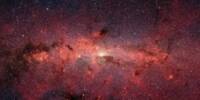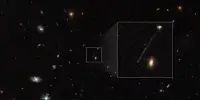The synthesis of three heavy elements in the aftermath of a gamma-ray burst (GRB) has been witnessed for the first time, helping to fill in the origins of more of the periodic table.
For a long time, the formation of elements with atomic weights greater than iron has remained a mystery. For most of their lives, stars convert hydrogen into helium, and towards the end, this can shift to slightly heavier elements. To manufacture anything other than iron, however, something more spectacular is required. It was originally considered that supernovae were responsible for anything heavier, but concerns began to emerge even before the first detection of a kilonova caused by neutron stars interacting.
Both sorts of star explosions are now assumed to contribute to the universe’s supply of heavier elements, with the relevance of each source differing depending on the element. However, in most cases, this is based on conjecture, as they have not been discovered in the spectrum produced by either type of explosion.

That is no longer the case, at least for tungsten, selenium, and tellurium, elements 74, 34, and 52, respectively.
“We were looking for the signature of heavy metal synthesis in the Universe, and it took a massive explosion to reveal it,” stated Dr Gavin Lamb of Liverpool John Moores University in an emailed statement. The event was the GRB 230307A gamma-ray burst, which was seen by JWST and was the second-brightest gamma-ray burst ever observed.
GRBs can be caused by a variety of events, but this one was caused by a kilonova, similar to others where we have observed gravity waves created by merging neutron stars. The GRB lasted 200 seconds, making it one of the longest explosions ever observed. Long and short bursts are assumed to have fundamentally distinct sources, and the link between kilonovas and GRBs lasting longer than two seconds is still unknown.
The afterglow was unexpectedly modest given the magnitude of the burst, yet JWST detected it in the mid-infrared 29 and 61 days after the gamma rays arrived. After accounting for the redshift of the galaxy thought to have hosted the event, this showed a spectral line at 2.15 microns, which scientists from 66 universities worldwide interpret as indicating the presence of tellurium.
The amount of tellurium produced is estimated to be one-thousandth the mass of the Sun, or around 300 times the mass of the Earth. This helps to explain why, while tellurium is extremely rare on Earth, it is relatively prevalent across the cosmos.
Apart from a more speculative identification in a prior kilonova, AT2017gfo, theoretical modeling implies that kilonovas should emit a lot of tellurium.
The presence of tungsten, selenium, or both is supposed to be indicated by a weaker line at 4.5 microns.
Tellurium is a relatively unknown element, with thin-film solar cells and semiconductors being its primary applications. More crucially, its existence likely implies the creation of elements next to it on the periodic table, including its immediate neighbor iodine, which is required for the manufacture of growth-regulating hormones.
Tungsten is best known as the metal with the highest melting point. Because of its high hardness, it is helpful in metal alloys. Selenium is a micronutrient that is needed for animals and is added to some meals to prevent deficits.
“We are now finally in a position to start filling in those last blanks of understanding where everything was made, just over 150 years after Dmitri Mendeleev wrote down the periodic table of elements,” Radboud University Professor Andrew Levan stated in another statement.















